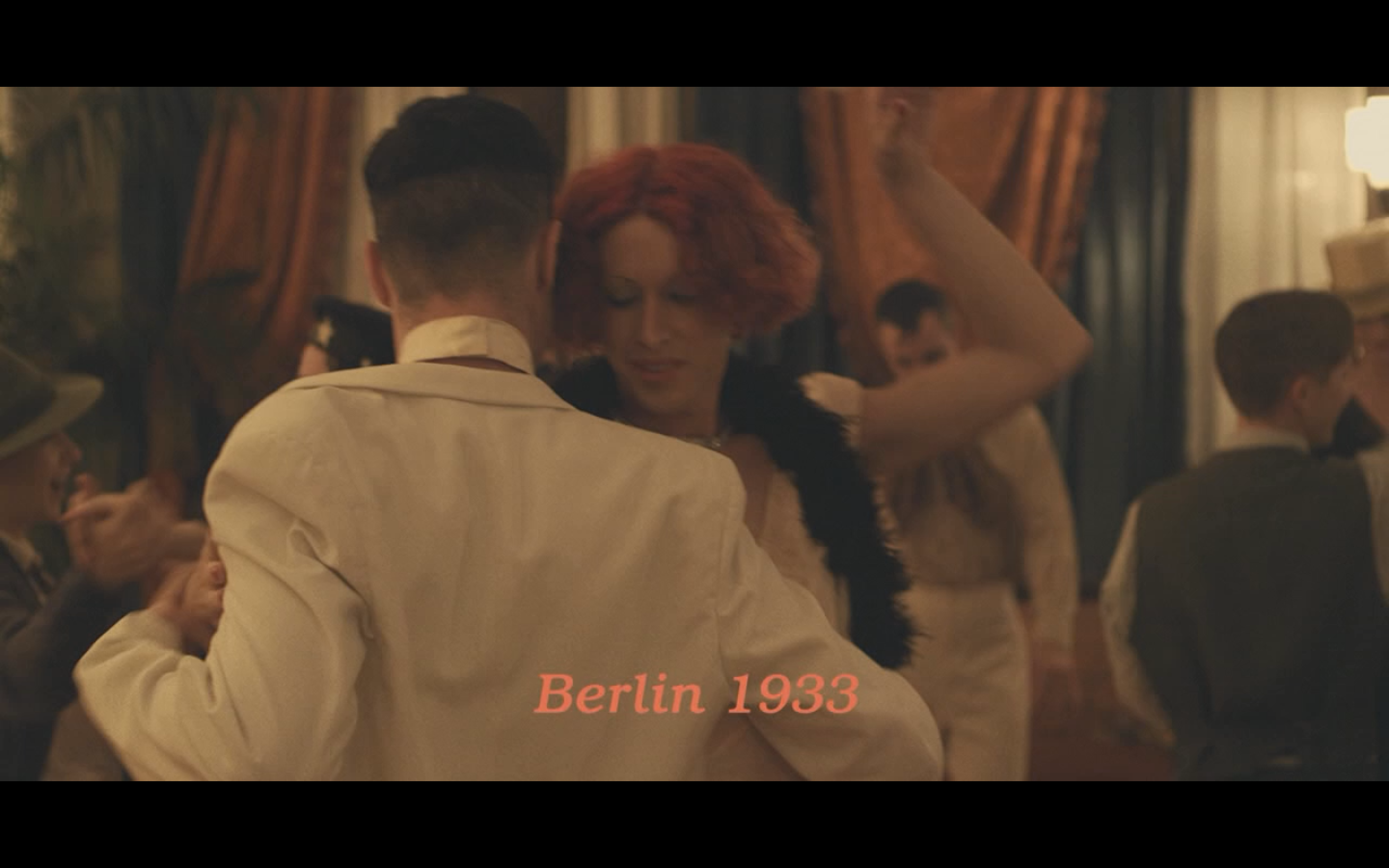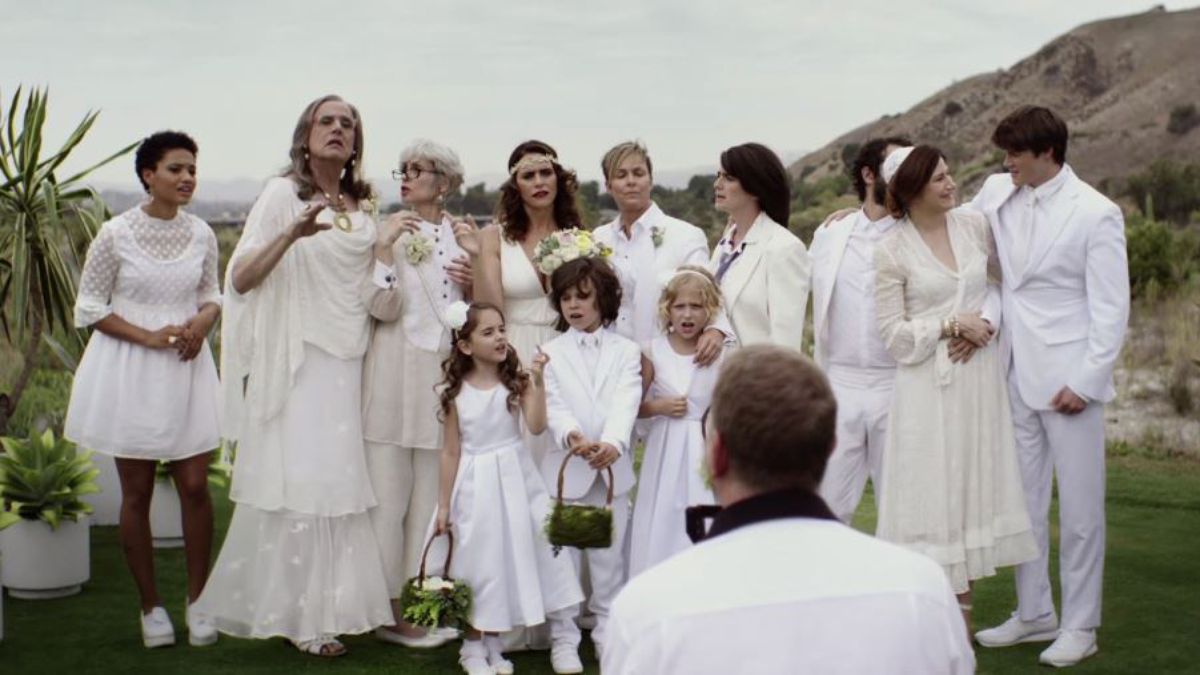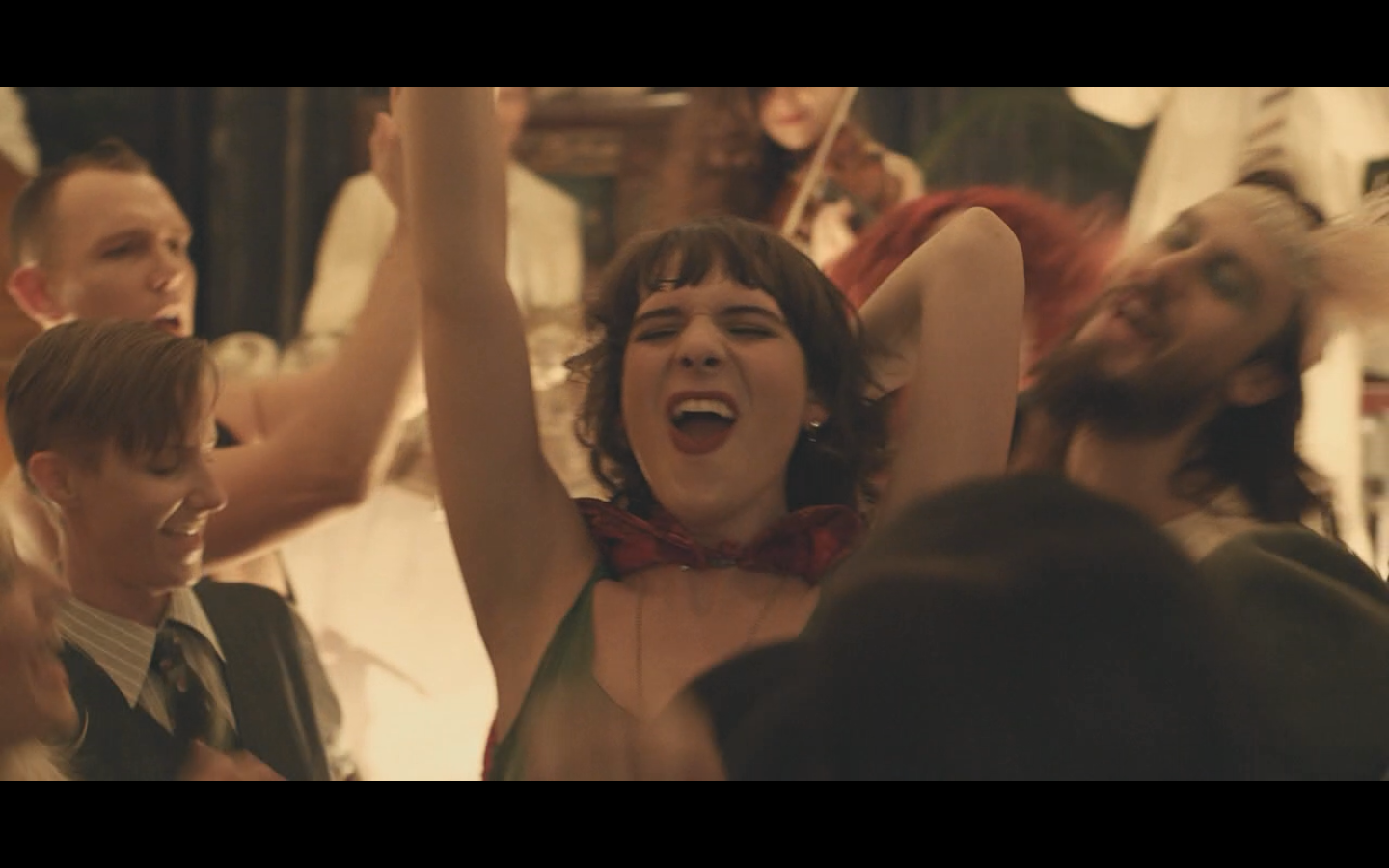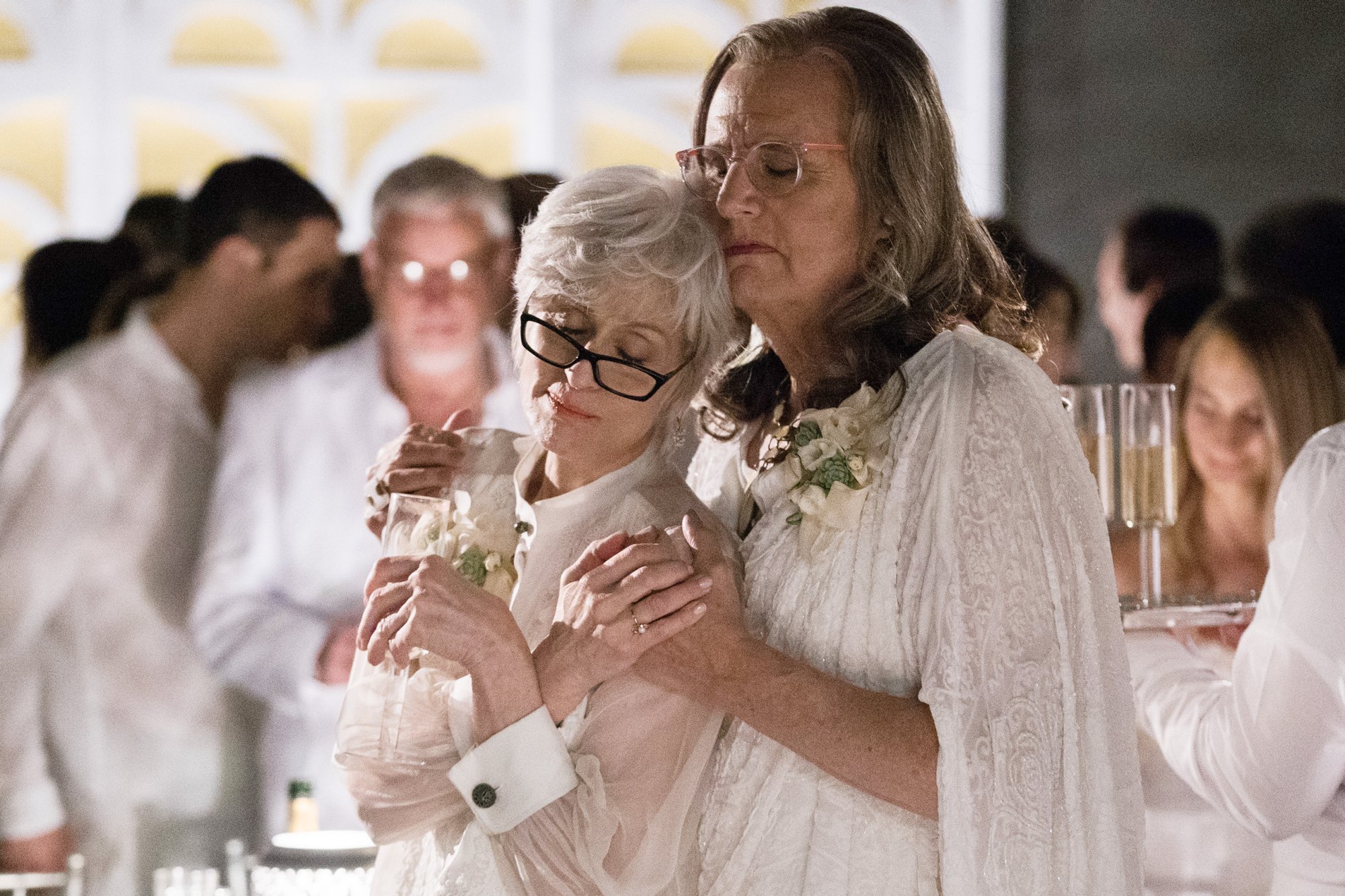What is the Significance of the Flashback in “Transparent,” Season Two, Episode One?
It was quick, yet impossible to miss. If you watched the season two premiere of Transparent (2014), you must have noticed Maura’s nephew break into a trance-like dance at Sarah and Tammy’s wedding. Suddenly the viewer is transported to another dancing scene, in 1933 Berlin. Nearly all are dressed in drag, and Maura’s cross-dressing businessman friend, Mark (Bradley Whitford), who appeared in two episodes in Season One, mysteriously appears. A fiddler plays with other live musicians on the stage as the dancers revel in the festive scene. What could this flashback possibly mean?
Despite cold feet, Maura’s daughter Sarah has just gone through with the ceremony and wed Tammy. At the reception, dancing ensues amongst the guests, who include Maura’s transsexual friend Davina (Alexandra Billings), Maura’s other daughter, the androgynously dressed Ali (Gaby Hoffman), her son, hypersexual-since-childhood Josh, and Josh’s current girlfriend Raquelle, a female rabbi. Maura herself (Jeffrey Tambor) is now comfortable making public outings dressed as a woman and asserting herself as such. It’s an LGBTQ wedding, which includes some more conservative hetero guests. Out of the gate, the flashback draws similarities between the Utopic acceptance of LGBTQ people at the Pfefferman wedding and in pre-Hitler Berlin.
Is this comparison historically accurate? Yes. The American Psychological Association states that Magnus Hirschfeld established Berlin’s Institute for Sexual Science in Berlin in 1919 (Morris, “History of Lesbian, Gay, & Bisexual Social Movements”) (i). Hirschfeld, a German doctor and early pioneer for gay rights, had also helped found the Scientific-Humanitarian Committee, a group that attempted to void German law of the criminality of homosexuality (“Magnus Hirschfeld” britannica.com)(ii). In addition to publishing, papers, books, and releasing films that promoted gay rights and acknowledged naturally-occurring variations in sexuality, Hirschfeld was homosexual himself (britannica.com) and made Germany one of the more friendly places in Europe for gays, transvestites, and other LGBTQ people. So, in fact, the flashback portrays what very well could have been one of the many gay or drag bars in Berlin in the early 20th century.
Of course, the guests at the Pfefferman wedding know what the revelers in the flashback don’t, that the party will soon be over. Just as the all-accepting vibe at the wedding is dashed by Maura’s sister Bryna’s harsh judgment of her trans lifestyle and declaration that Maura is forbidden from subjecting their dying mother to her new female appearance, so the party in the flashback will also be dashed by Hitler and the Nazis’ rise to power, which began with his appointment as German chancellor in 1933.

Perhaps the show is highlighting what seems to be a constant battle between tolerance and understanding, as signified by the LGBTQ-friendly climate in pre-Hitler Berlin and the Pfeffermans’ progressive attitude toward sexuality, versus the brutal attempt to categorize people into higher and lower beings, also known as bigotry, intolerance, discrimination, prejudice. Although Hitler is not referenced in the flashback, the broadly known Nazi history during the 1930’s and 40’s inherently suggests that the guests depicted in scene are or soon will be in trouble, or, at the very least, are enjoying their last freedoms. In the contemporary plot line, Maura’s sister Bryna imposes a suppression of Maura’s sexuality that is, by comparison, suggested to be fascist. Bryna symbolizes the force of bigotry working against Maura’s transition (and sexual freedom or fluidity in general), which is underpinned by its comparison to much more extreme historical intolerance. Earlier, as Sarah walks down the aisle, we see heightened, surreal moments of guests laughing at her, highlighting the perceived judgement that Sarah feels from her guests. This serves as another example of the Pfeffermans dealing with forces of (and fears of) bigotry in their sexually fluid lifestyle, as does her exclusion—perhaps due to feeling it an outdated tradition—of the father-daughter dance at the reception. Sarah’s perception of the judgement from the wedding guests, and the heteronormative world, culminates when she recants her marital commitment to Tammy, shutting the door on what might have been an idyllic queer future for her.
The Jewishness of both the flashback and the wedding scene is as palpable as the LGBTQ-friendly environment, as evidenced by the fiddler in the Berlin scene and the enchanting performance of the Hebrew folk song “Hava Nagila” at the wedding (see also, the Yiddish title of the episode, “Kina Hora”, meaning “evil eye”). As we all know, Hitler’s rise to power resulted not only in the end of LGBTQ advocacy in Germany but also in the persecution and mass murder of Jews. The link between the contemporary gathering of Jews for the wedding and the Jewish folk music playing in the flashback reinforces the analogy between what occurs in World War II-era Germany and the rebuttals and intolerance experienced not only by Maura but also by her children in this episode.

For example, the opening scene depicts the Pfefferman’s trying to execute a wedding photo. When Sarah’s mother, Shelly, asks the photographer to help the family feel comfortable posing by using a Jewish alternative to “say cheese,” the photographer suggests, “I think I want a little wine,” which both parents point out is Anti-Semitic. Additionally, the shame Sarah is made to feel about “not having any people,” in comparison with Tammy’s entourage as guests also highlights the backstory of shame and Anti-Semitism at the wedding, particularly since Tammy’s family is referred to as WASPs by Sarah. Perhaps the show’s creator, Jill Soloway, is highlighting the special challenge that the Pfefferman family faces in being a double minority. By being both trans and Jewish, bi and Jewish, or sexually curious and Jewish, the family’s members grapple with both an inherited culture of shame and secrecy—a result of the historical persecution of the Jews—and with current homophobia and fearful intolerance of their LGBTQ lifestyle.
The brief flashback in Episode One is not a one-off, but is further explored in an ongoing storyline in Season Two. Thus the connections being drawn between Germany on the brink of war and the Pfefferman family’s sexual evolution are further developed in later episodes. Still, the choice to insert the first flashback in that storyline, brief and unexplained, in the middle of Sarah’s and Tammy’s wedding reception just before Sarah ends the marriage, has a strong and intriguing symbolic resonance.

The final scene, which sweeps across four hotel rooms occupied by the wedding party, cross-sections the scope of the family’s burden. Be it Josh’s low self-esteem and his tendency to pass that judgment on to those he cares about, Sarah’s and Tammy’s mourning for their short-lived marriage, Shelly’s and Maura’s drastic reinvention of their partnership, or Ali’s brooding and bicurious self-consciousness, the show suggests that the cost of holding a double minority status takes a heavy toll on the characters’ spirits. As both Ali and a character from the flashback (played by trans model and actress Hari Nef) gaze off into the distance from the hotel balcony, seemingly grasping each of their respective and dismal prospects for acceptance, the shows seems to being asking, “Are you willing to pay the cost of being yourself, even if it differs from and challenges others?”
As both seasons of Transparent attest, the consequences of being queer, Jewish, or other in any way have been and can be miserable—and in some contexts, may equal the costs of living a lie. The Pfefferman family’s tolerance of each other’s sexual fluidity, though imperfect, does hold them together, in spite of opposing forces of conservatism and intolerance working from within and without. These moments of acceptance, of Utopian familial love, are sprinkled in moderately and, in combination with the creators’ razor-sharpy sense of irony and dark humor, result in a magical reinvention of the family dramedy.

Works Cited:
(i) Morries, Bonnie J. “History of Lesbian, Gay, and Bisexual Social Movements.” American Psychological Association. n.d. Web. 9 December 2015.
(ii) “Magnus Hirschfeld.” Encyclopædia Britannica. Encyclopædia Britannica Online.
Encyclopædia Britannica Inc., 2015. Web. 10 Dec. 2015 <http://www.britannica.com/biography/Magnus-Hirschfeld>.

